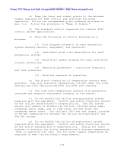
MIL-HDBK-1003/3
Section 4: INFORMATION REQUIRED ON DRAWINGS
4.1 General. Drawings shall provide a clear presentation
of system design, and shall include items noted in project
specifications by such terms as "where indicated," "as shown,"
etc. Refer to the local A/E Guide for additional requirements.
Provide complete details of equipment, systems, and controls on
project drawings as follows:
4.1.1 Identification of Drawings. Ensure that the drawings
list, sheet numbers, and sheet titles on mechanical sheets match
exactly as shown on the cover sheet and in specifications.
4.1.2 Equipment Schedules. Provide schedules of mechanical
equipment.
4.1.3 Duct Pressure Classifications. Include duct pressure
classifications on drawings to ensure ducts meet SMACNA
construction standards. Evaluate the effect of closed fire
dampers on duct pressure when determining pressure
classification; include pressure relief devices as required to
limit pressure buildup. See Figure 10 for examples or follow
SMACNA.
4.1.4 Riser Diagrams. Riser diagrams drawn to vertical scale
should be provided for mechanical systems in multi-story
buildings. These shall indicate size changes in vertical piping
runs. See Figures 38 and 39 for examples.
4.1.5 Controls. Include schematics (control loops) and
ladder diagrams (see Figures 33, 34, and 35 for examples),
sequences of operation, and equipment schedules (see Tables 15,
16, and 17 for examples). Include the following information to
the maximum extent possible without being proprietary:
a) The schematic should show control loop devices and
permanent indicating instrumentation, including spare thermometer
wells.
b) Schematic and ladder diagrams should show interface
points between field installed HVAC control systems, factory
installed HVAC control systems (e.g., chiller and boiler
controls), fire alarm systems, smoke detection systems, etc.
c) The ladder diagram should show the relationship of
devices within HVAC equipment (e.g., magnetic starters) and other
control panels.
38
Simpo PDF Merge and Split Unregistered Version - http://www.simpopdf.com

MIL-HDBK-1003/3
d) The equipment schedule should show information that
the vendor needs to provide instrumentation with properly
calibrated ranges; to select proper control valves and associated
actuators; to adjust control system devices for sequencing
operations; to configure controller parameters, such as setpoints
and schedules; and to set the control system time clocks.
Indicate control valve flow coefficient (Cv) and pressure drop
for every control valve.
e) Locations of devices and instrumentation should be
indicated. Provide space, access, lighting, and appropriate
mounting heights to read the instrumentation and set control
devices.
f) Provide electrical surge protection on HVAC control
devices as required to protect the DDC and EMCS.
g) Each control system shall have a sequence of
operation. The sequence of operation should be shown on drawings
adjacent to the schematic. After a standard has been adopted by
industry, provide graphical schematics for sequence of operation
of DDC systems on drawings.
h) Provide an input and output schedule for DDC
systems. Schedule shall include a description of the device,
type of point, and any special requirements.
i) A commissioning procedure for temperature controls
should be specified and should detail how the vendor will inspect
calibrate, adjust, commission, and fine tune each HVAC control
system. Refer to par. 8.6.
j) Project specifications should specify the
coordination of HVAC system balancing with the temperature
control system tuning. Specifications should require that
balancing be completed, the minimum damper positions be set, and
the balancing report be issued before the control systems are
tuned.
k) Project specifications should list submittal
requirements for the vendor.
4.1.6 Maintainability. Lack of maintenance contributes to
poor performance of most systems throughout the Navy's shore
facilities. This is due primarily to poor working conditions
brought about by lack of design detail on drawings to ensure an
installation with adequate accessibility for ease of operation
and maintenance. Equally important are drawings that clearly
represent the intended system arrangement and describe system
39
Simpo PDF Merge and Split Unregistered Version - http://www.simpopdf.com

MIL-HDBK-1003/3
operation. To preclude this in the future include the following
on drawings:
a) Identification of floor area required to remove
equipment components such as filters, coils, heat exchanger
tubes, bearings, etc. In equipment rooms, require that floor
space be identified by striping with yellow paint.
b) Equipment elevations and room sections to clearly
identify equipment arrangement which provides sufficient access
for equipment operation and maintenance.
c) Location of permanent ladders, catwalks, and
platforms required to access and maintain overhead equipment.
Minimize the use of elevated equipment wherever possible.
d) Use two dimensional pipe drawings (with dimensions
indicated as necessary) for congested spaces to ensure that
equipment and piping will be installed as intended with adequate
personnel space available for operation and maintenance.
4.1.7 Symbols and Abbreviations
4.1.7.1 General. Provide a list of symbols and abbreviations
on the title sheet of the project. Use symbols and abbreviations
that are common to the trade as contained in ASHRAE handbooks.
For larger projects, each discipline may have their corresponding
lists on the first sheet of their group of drawings.
4.1.7.2 Specifics. Limit symbols and abbreviations to items
that are actually in the project. Limit abbreviations to items
that occur more than once in the project.
4.1.8 Building Column Lines and Room Names. Ensure that
building column lines and room names are identical to those shown
on architectural drawings.
40
Simpo PDF Merge and Split Unregistered Version - http://www.simpopdf.com

MIL-HDBK-1003/3
Section 5: LOAD CALCULATIONS
5.1 General. Refer to par. 2.1.1.2 for the selection of
outdoor and indoor design conditions. Manual procedures provided
below for determining heating and cooling loads are generally
only applicable to small systems (e.g., heating systems less than
200,000 Btu per hour and cooling systems less than 10 tons).
Computer programs are available that will provide more precise
load determinations and the time of day with the highest cooling
load. The highest heating load is assumed to occur just before
dawn; therefore, this should be considered in the design heating
load.
5.2 Heating Load
5.2.1 Transmission
EQUATION: Q = U * A * (T - T ) (1)
i o
where: Q = Btu/hr heat loss by transmission,
U = heat transfer coefficient (look this up in a
handbook for your particular wall, floor, roof, etc.),
A = area of the surface (wall, window, roof, etc.),
T = inside design temperature, and
i
T = outside design temperature.
o
Use this formula to compute heat transmission losses
from each element of the building skin (e.g., walls, windows,
roof, etc.). Note that attic and crawl space and ground
temperature are different from outdoor temperatures.
5.2.2 Infiltration and Ventilation. To determine the heating
load use the larger of the infiltration and ventilation loads.
Outdoor air provided for ventilation should exceed the air
exhausted by 10 to 15 percent to minimize infiltration. The
designer must use judgment on the amount of excess supply air to
include based on number and type of windows and doors.
EQUATION: Q = 1.10 * CFM * (T - T ) (2)
i o
where: CFM = cubic feet per minute of outdoor air, and
Q = the sensible heat loss, Btu/hr.
41
Simpo PDF Merge and Split Unregistered Version - http://www.simpopdf.com

MIL-HDBK-1003/3
This section does not apply to industrial ventilation
systems, e.g., systems to control fumes, vapors, and dust from
such processes as plating, painting, welding, and woodworking.
Refer to the MIL-HDBK-1003/17 and ASHRAE Handbook, HVAC Systems
and Applications, for guidance on design of these systems. The
EFD or EFA and the Naval Facilities Engineering Service Center
(NFESC) can provide additional assistance.
5.2.3 Total Heating Load. Sum the transmission loads with
infiltration and ventilation loads to get the total heating load.
To this computed total heating load, add the following to size
central equipment (do not apply these factors when sizing
terminal equipment such a finned-tube radiation, fan-coil units,
etc.):
a) Exposure factor (prevailing wind side) up to 15
percent.
b) Pickup (for intermittently heated buildings with
primary heat sources such as boilers, steam-to-water heat
exchangers, etc.) 10 percent.
c) Buildings with night setback. A residence with 10
degrees F setback requires 30 percent oversizing for acceptance
pickup and minimum energy requirements.
5.3 Cooling Load. Computation of the peak cooling load can
be a difficult effort. Heat gain is composed of or influenced by
the conduction heat gain through opaque portions of the building
skin; the conduction plus solar radiation through windows and
skylights; the building internal loads such as people, lights,
equipment, motors, appliances, and devices; and outdoor air load
from infiltration. For sizing VAV systems, calculation of loads
has more stringent requirements. Refer to Appendix C.
5.3.1 Transmission
5.3.1.1 Walls and Roof
EQUATION: Q = U * A * (T - T ) (3)
o i
Refer to par. 5.2.1 for definition of terms.
5.3.1.2 Glass
a) Transmission
EQUATION: Q = U * A * (T - T ) (4)
o i
42
Simpo PDF Merge and Split Unregistered Version - http://www.simpopdf.com

![Hệ thống HVAC và Dehumidifying: Tổng quan [Năm hiện tại]](https://cdn.tailieu.vn/images/document/thumbnail/2012/20120202/luly_meo1/135x160/hvac_and_dehumidifiying_systems_b_split_14_8134.jpg)
![Hệ thống HVAC và Dehumidifying: Tổng quan [Năm hiện tại]](https://cdn.tailieu.vn/images/document/thumbnail/2012/20120202/luly_meo1/135x160/hvac_and_dehumidifiying_systems_b_split_13_3651.jpg)
![Hệ thống HVAC và Dehumidifying: [Thêm từ mô tả/định tính để tăng CTR]](https://cdn.tailieu.vn/images/document/thumbnail/2012/20120202/luly_meo1/135x160/hvac_and_dehumidifiying_systems_b_split_12_8041.jpg)
![Hệ thống HVAC và Dehumidifying: [Thông tin chi tiết/Hướng dẫn/Lựa chọn]](https://cdn.tailieu.vn/images/document/thumbnail/2012/20120202/luly_meo1/135x160/hvac_and_dehumidifiying_systems_b_split_11_4149.jpg)
![Hệ thống HVAC và hệ thống hút ẩm: [Thông tin chi tiết/Hướng dẫn/Lựa chọn tốt nhất]](https://cdn.tailieu.vn/images/document/thumbnail/2012/20120202/luly_meo1/135x160/hvac_and_dehumidifiying_systems_b_split_10_7992.jpg)
![HVAC và Hệ thống Hút Ẩm: [Thêm thông tin chi tiết để tối ưu SEO]](https://cdn.tailieu.vn/images/document/thumbnail/2012/20120202/luly_meo1/135x160/hvac_and_dehumidifiying_systems_b_split_9_3668.jpg)

![HVAC và Dehumidifying Systems: Hệ thống điều hòa không khí và hút ẩm [chuẩn SEO]](https://cdn.tailieu.vn/images/document/thumbnail/2012/20120202/luly_meo1/135x160/hvac_and_dehumidifiying_systems_b_split_7_2859.jpg)
![HVAC và Dehumidifying Systems: [Mô tả chi tiết/Hướng dẫn/Đánh giá]](https://cdn.tailieu.vn/images/document/thumbnail/2012/20120202/luly_meo1/135x160/hvac_and_dehumidifiying_systems_b_split_6_8164.jpg)
![Hệ thống HVAC và Dehumidifying: [Thông tin chi tiết/Hướng dẫn/Lựa chọn]](https://cdn.tailieu.vn/images/document/thumbnail/2012/20120202/luly_meo1/135x160/hvac_and_dehumidifiying_systems_b_split_5_3816.jpg)








![Ngân hàng trắc nghiệm Kỹ thuật lạnh ứng dụng: Đề cương [chuẩn nhất]](https://cdn.tailieu.vn/images/document/thumbnail/2025/20251007/kimphuong1001/135x160/25391759827353.jpg)






